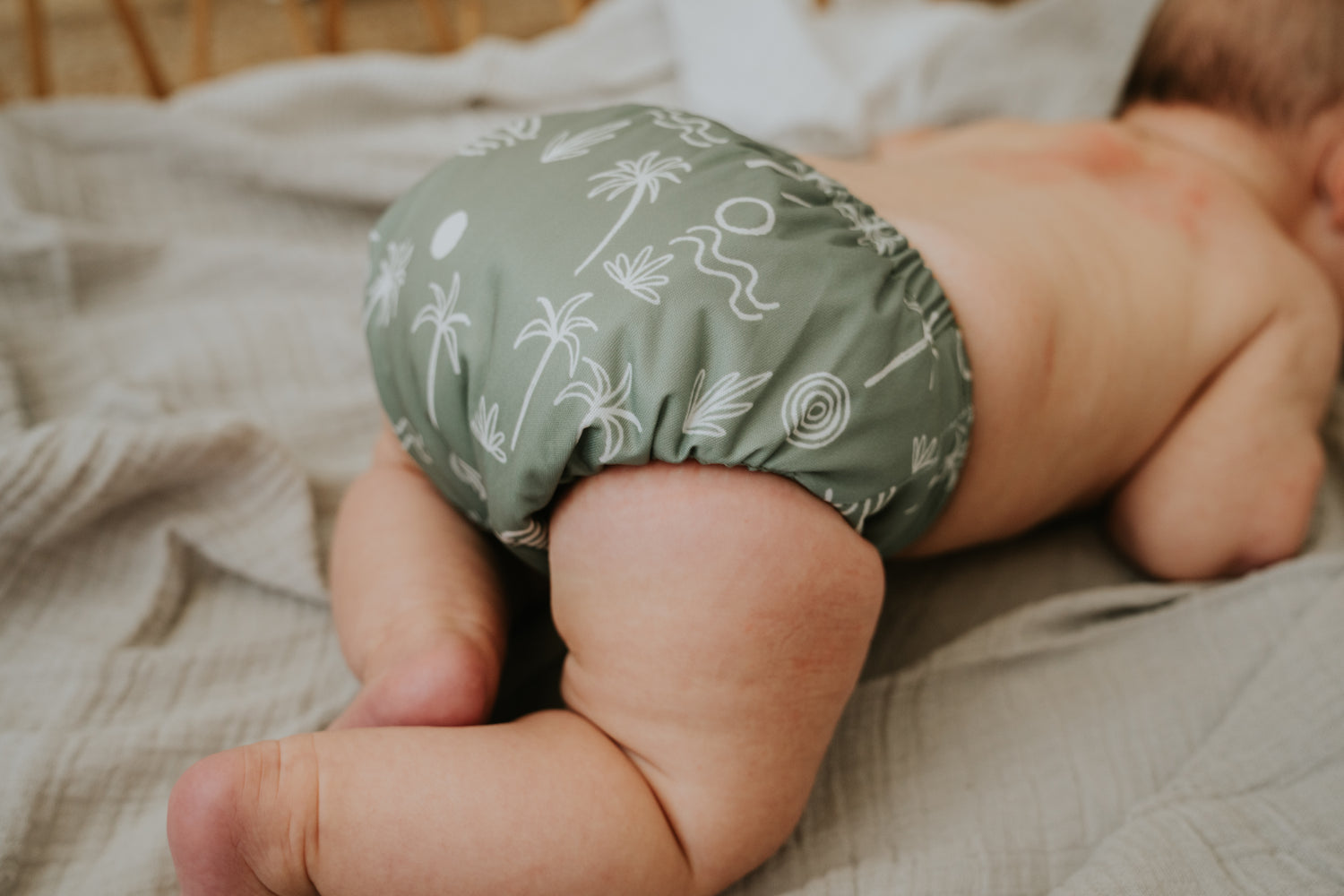Starting out in the cloth nappy world can be super overwhelming and there are plenty of options available, here's a quick run down of the styles available.
TRADITIONAL STYLE CLOTH
Traditional cloth or ‘terry’ squares
This is what people imagine when they think of the traditional term 'cloth nappies', it's the basis of where cloth nappies started and what most of us wore tots. These cloth nappies are made of fabrics do a good job at absorbing large amount of liquid, usually terry or flannelette cotton, hemp, bamboo or a blend. They fit comfortably as they are folded to suit bub and work best with a leak-proof cover. They are a great and cost effective option of cloth, however can be bulky and fiddly with pins and clips. As they are folded individually for each wear they fit children of all ages and are extremely fast drying.
Advantages: Cost effective and will give a great fit to bub. This helps with the poo-splosions!
Disadvantages: Can be fiddly and require more 'parts' than modern cloth nappies.
Pre-folds
A step up from traditional cloth nappies, these nappies are made of soft layers of fabric, like cotton or bamboo, which are folded over into a pad shape and placed inside a fitted, leak-proof cover. The benefits are they they are cost effective, they dry quickly, however you may need two or three different sizes.
Advantages: Cost effective and will give a great fit to bub, easier to put together than standard 'flats'. They can also be used once bub outgrows these as a booster of insert in a pocket nappy.
Disadvantages: Some prefolds are sized and more may need to be purchased.
Here's some images below of generally how a prefold works!




Fitted nappies
These are also called contoured or shaped nappies which are commonly made of layers of cotton, fleece, hemp or bamboo. Visually they are shaped like a disposable nappy, however some require a waterproof cover over the top to ensure they are leak proof. Fitted nappies are available in either one size fits most or individually sized nappies which are fastened with either velcro or press-studs. They are more expensive that the traditional cloth and pre-folds however they are extremely absorbent and are great night time solutions.
Advantages: Super adsorbent and will give a great fit to bub, as they are a shapped like a nappy fit they are easier to put together than standard 'flats' or 'pre-folds'.
Disadvantages: May be a sized option and only last a limited amount of time, generally will take longer to dry.
* All of the above options are great for newborns as the fit can be folded closer to bub avoiding any gapes around legs.


MODERN CLOTH NAPPIES
Pocket nappies
These cloth nappies have a leak-proof outer shell sewn together with a soft inner layer. There are inserts have a ‘pocket’ between the shell and the inner layer to insert a layer of padding. As pictured below the insert is laying on top of the shell, this can be worn as is below, but generally this insert is stuffed inside the hidden pocket.
The pocket nappy is easy to use and dry quickly as the insert can be removed from the nappy, but you need to take out the inserts before washing and put them back in afterwards. They come in one-size-fits-most and different sizes, this is all dependent on the brand. We currently stock the Alva Baby which is a OSFM pocket nappy style.
Advantages: Simple and easy to use, lots of great colours and designs available. Absorbency is very customisable, this is the most popular style of cloth nappy which is commonly used.
Disadvantages: As shells and inserts need to be seperated before they are washed some users find these fiddly when 'stuffing' inserts prior to use.
All-in-ones (AIO)
The all in one cloth nappies combine a water-resistant outside layer sewn together with an absorbent inner layer, making them a 'all-in-one' nappy. They’re shaped and can be fastened with velcro, clips or press studs. These are the closest to disposable nappies.
Advantages: Simple and easy to use, lots of great colours and designs available. Don't need to be pulled apart for washing or drying.
Disadvantages: As the nappy is completely one unit they do take longer to try. All in one styles are harder to customise for your child if they require more absorbency.
All-in-twos or ‘snap-in-ones’ (AI2)
Very similar to the pocket nappy, however these cloth nappies have a ‘snap-in’ layers or ‘boosters’, which you take apart for washing. So in overview there is the outer shell which consists of the waterproof over and fabric lined inner, and then there are the added inserts which are clipped in to boost the absorbency of the nappy. They dry faster than all-in-ones as they are separated for washing and the 'inners' can be replaced if required over time. As the absorbent layer sits on top of the shell, they can be more cost effective as you can purchase more inners than shells and only replace the inners at change time.
Example of an all in two style is the Bambooty BASICS, and Bubblebubs Candies.
Advantages: Simple and easy to use, lots of great colours and designs available. Inners can be replaced if damaged or lost, boosters can be added easily for more absorbency.
Disadvantages: Initially can be costly. Require to be laundered separately (like pocket nappies) so can be fiddly.
Bambooty BASICS pictured below - just note that this nappy unlike the pocket nappy above doesn't have a pocket, under the top of the insert there are two snaps which clip the insert into place.






